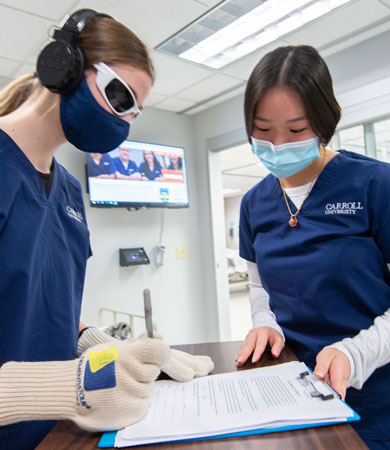 Students wear special accessories to experience the sensory simulation.
Students wear special accessories to experience the sensory simulation.
Sensory Simulation Builds Empathy in Healthcare Students for People with Dementia
Jena Weber's '21 pursuit of a doctor of physical therapy degree at Carroll University has steered her toward opportunities to learn more about how to care for people with dementia. Personally motivated in her studies by seeing the effects of dementia on her two grandfathers, she eagerly embraced a chance to experience a dementia simulation offered in one of her classes.
"Being able to understand what they're going through from a physical perspective and actually experience it ourselves rather than being like, 'Well, yeah, I read this in a book,' kind of gives us a little bit more knowledge," said Weber, who plans to graduate with her doctor of physical therapy degree in 2023. "We have a better understanding, so we can kind of empathize with them more."
Carroll is the only four-year institution of higher education in Wisconsin right now to offer the Virtual Dementia Tour (VDT). P.K. Beville, an award-winning geriatric specialist and founder of the nonprofit Second Wind Dreams, based in Roswell, Georgia, created the simulation. According to the organization, the simulation immerses participants in a dementia experience, so they gain an understanding and build empathy for people living with dementia.
The simulation makes it difficult for participants to interpret their environment by confusing their senses. Wearing special goggles, gloves, shoe inserts and headphones they enter a two-room simulation setting in the Waukesha Free Clinic at Carroll University, where they have eight minutes to complete a list of five tasks. A second VDT experience is also available to nursing students inside on-campus labs to simulate a hospital setting.
Weber said that entering the simulation room, she felt anxious and overwhelmed by the various obstacles that accompanied the assigned tasks. By the end of the simulation, she had gained a better understanding of not only what her family members have gone through with dementia, but what others might experience as she cares for them.
"I'm like, 'Oh, wow. This is what people go through,'" she said. "I understood how frustrating it was to complete those tasks independently because there are just so many things that could go wrong."
As the population of the United States ages and the numbers grow for people diagnosed with Alzheimer's disease and other dementias (ADRD), the training for healthcare workers is inadequate to deal with the crisis, said Karie Ruekert Kobiske, Ph.D., R.N. Kobiske is the director of Carroll's
Master of Science in Nursing program and a clinical associate professor of nursing. She and Sara Deprey, PT, associate professor and chair of Carroll's Physical Therapy Department, are Carroll's two VDT-certified trainers.
“Sara and I are determined to provide geriatric education to these students so that they are able to better care for our aging society,” Kobiske said. Because healthcare students are usually under the age of 30, with most being in their early 20s, the “life experience for these students has limited understanding of dementia,” she said.
Kobiske notes that current projections show that as the U.S. population increases, chronic illnesses such as ADRD will increase from 6.2 million Americans in 2021 to 7.2 million by 2025, and to more than 13.8 million by 2060.
With such statistics in mind and determined to strengthen the healthcare workforce to tackle such issues, Kobiske and Deprey traveled to Atlanta to receive training from Second Wind Dreams in February of 2020. A $15,000 grant from Bader Philanthropies to develop geriatric education for Carroll’s health science students helped fund the training. They also received additional funds for supplies through a Carroll University Faculty Development grant.
"My hope was it would make a difference. I was extremely excited, and it actually brought tears to my eyes after we read the qualitative data (written feedback from students) that we got back that, 'Hey, this worked.' We did something and it worked and it was really great and the students were moved and are changing the way they work with older people," Kobiske said.
Deprey added, “We've had many students that it really had an emotional impact. I couldn't have done that as a teacher. I just can't do that. It's nice that they can experience it.”
About 500 nursing and physical therapy students have participated in the VDT since Carroll added it to the curriculum in the fall of 2020. Instructors anticipate about 350 students will annually undergo the training, which, according to Second Wind Dreams, has also been experienced by 3 million people in 20 countries.
Through the VDT experience, Second Wind Dreams hopes to influence the type of care that will be offered to adults as they age in all settings, said Gwenyth Johnson, chief executive officer for the organization. She said the VDT is designed to change the perception of aging.
"Each person who develops a greater understanding of dementia will move us closer to a dementia- and age-friendly society," Johnson said. "As we work to create this understanding, dispel fear and create relationships at the grassroots level, we change the world where we will age – and our ability to age well."
The Virtual Dementia Tour, created by P.K. Beville, is a scientifically-proven method of building a greater understanding of dementia through the use of patented sensory tools and instruction. Proceeds from the sale of the Virtual Dementia Tour support the work of Second Wind Dreams, an internationally known nonprofit dedicated to changing the perception of aging through the fulfillment of elders' dreams.